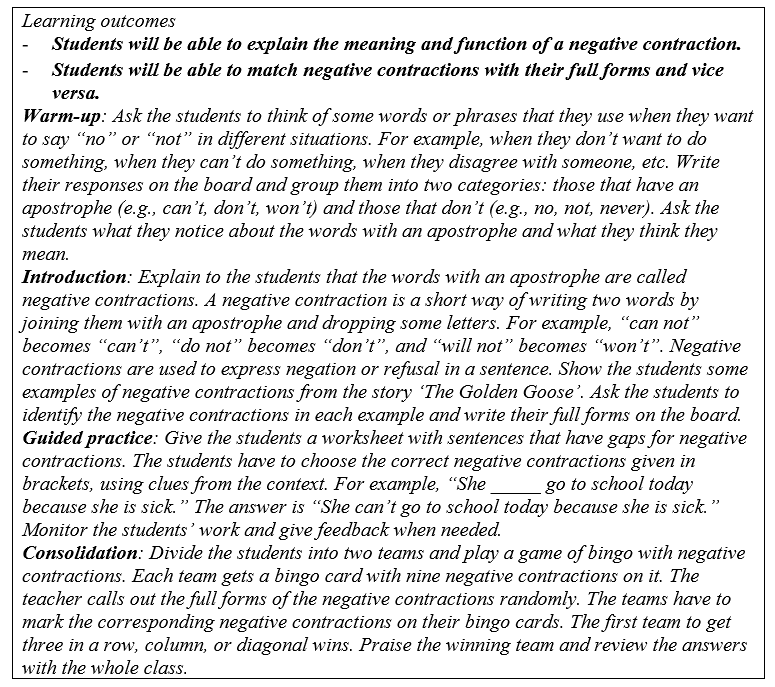...and why they are important.

Hello and welcome to the 47th edition of our fortnightly newsletter, Things in Education.
Over the past year, we have been meeting with a group of primary school teachers every month. During these monthly meetings, we discuss lesson planning essentials, limits of working memory, planning for long-term memory retention, and choosing teaching strategies best suited to students' understanding levels. In one of our earliest meetings, the Grade 4 English teachers shared with us the challenges they faced in teaching grammar. To understand their challenges better, we planned to observe some of their lessons.
On the day of the observations, the teachers showed us the lesson plan for the grammar concept of ‘negative contractions’ that they had prepared together. It looked something like this:

Here is a transcript of the notes we made as we observed the lesson in action:

At this point, we decided to focus our sessions with teachers on what good learning outcomes are and why they are important. We realised that without the foundation of learning outcomes, theories of learning wouldn’t make much difference to what is actually happening in the classroom. Here is a summary of our discussions:
A good learning outcome focuses on the learner.
The learning outcome that the teachers wrote in their lesson plan focused on what the teacher would do:
We will teach negative contractions by finding examples.
This is a common but crucial mistake. A good learning outcome MUST focus on the learner, and an easy way to do this is to always begin a learning outcome with the following words:
Students will be able to...
This simple but, again, crucial change forces us to think about the students and their learning and not about what we, as teachers, will do during our lessons.
A good learning outcome includes an observable behaviour.
Once the focus is on the students, we have to identify a specific behaviour that students should exhibit by the end of the lesson. This should be written in the learning outcome in the form of a verb, and Bloom’s Taxonomy is a good place to start to find such verbs.
At the same time, the behaviour must be observable, so that we as teachers are able to quickly assess student learning. This means that verbs like ‘understand’, ‘learn’, ‘appreciate’, ‘comprehend’, and ‘know’ should be avoided, because these are vague verbs that do not talk about observable behaviours. Instead, verbs like ‘identify’, ‘match’, ‘explain’, ‘describe’ and ‘compare’ should be used, because these are concrete verbs that can be observed when students fill in worksheets, do activities or talk about what they have learnt.
Students will be able to [observable behaviour]...
A good learning outcome clearly specifies the knowledge/skill to be learnt.
Most knowledge concepts and skills we teach in school are very broad and include many different components. Let’s take the example of negative contractions – to be able to use negative contractions correctly, we have to understand:
1) what ‘negative’ implies
2) what a ‘contraction’ means
3) what the function of negative contractions is
4) how contractions are different from possessives
5) what the rules of formation of negative contractions are
6) what some common exceptions to these rules of formation are
The learning outcome written by the teachers in our example focused on ‘negative contractions’ as a whole, without specifying which component of knowledge or skill they want students to learn:
We will teach negative contractions by finding examples.
However, if our focus is so broad, students will face confusions of the kind that we wrote about in our observations note. To ensure that students learn all components in a step-by-step manner, the learning outcome must include specific details of the knowledge or skill.
Students will be able to [observable behaviour] [specific knowledge/skill]...
A good learning outcome focuses on the result of learning.
The learning outcome should focus on WHAT students will learn and not on HOW students will learn. (The HOW is the responsibility of the lesson plan.) If the learning outcome talks about HOW students will learn, the focus shifts to ensuring that the process is followed perfectly. The learning outcome written by the teachers in our example focused on ‘finding examples’ as the process – because of which the teacher might end up spending time ensuring that students find examples of negative contractions and not what contractions are and how they are formed.
We will teach negative contractions by finding examples.
And so, a learning outcome must focus on the result of learning by stating what students will be able to do and not how they will do it.
Students will be able to [observable behaviour] [specific knowledge/skill] xx process of learning xx...
By the end of our discussion, the teachers and we were able to come up with a list of 4 clear, specific learning outcomes that met all 4 criteria:
Students will be able to explain the meaning and function of a negative contraction.
Students will be able to match negative contractions with their full forms and vice versa.
Students will be able to differentiate between negative contractions and possessive words with an apostrophe.
Students will be able to apply the rules of forming negative contractions.
We used the first two learning outcomes to create one lesson plan with teachers, which looked something like this:

Learning outcomes that meet all 4 criteria not only make lesson planning and classroom teaching smoother and more focused, but also make it easier to assess students, identify misconceptions and gaps in understanding, and plan re-teaching and remediation.
We are working on a fantastic new teaching tool called TEPS, which will provide you with research-backed teaching strategies aligned to clear learning outcomes. Watch this space! If you are interested in getting early access to TEPS, please sign up here.
If you found this newsletter useful, please share it.
If you received this newsletter from someone and you would like to subscribe to us, please click here.
Edition: 2.21

Comentarios